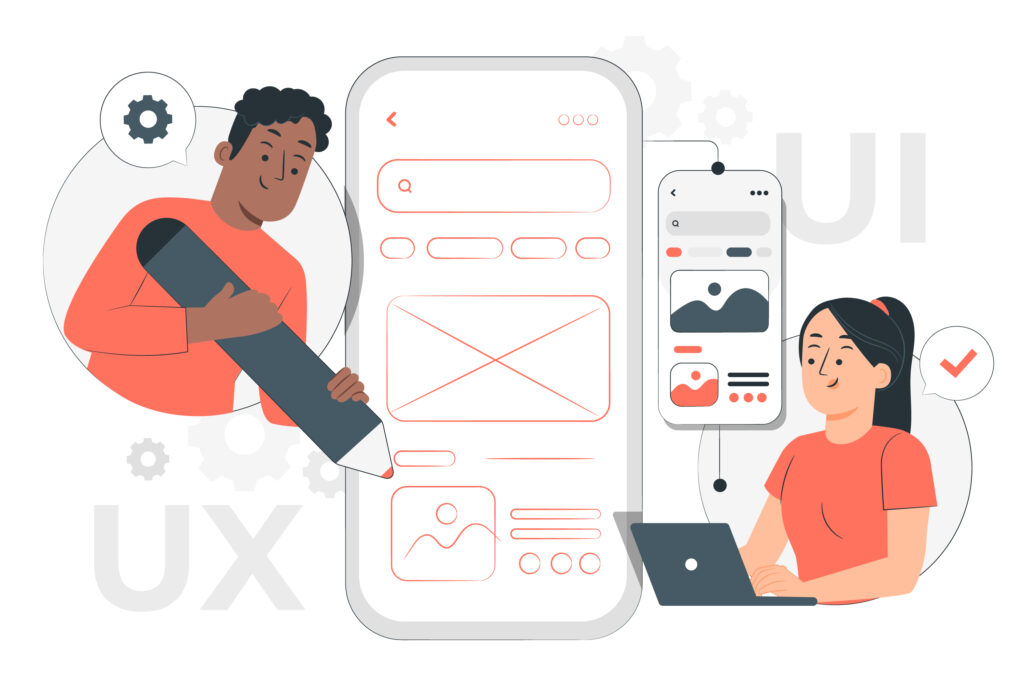Importance and Benefits of Responsive Website Design
Responsive Web Design is a method employed by developers to build websites that adjust seamlessly to different browsers, screen sizes, and operating systems. As a result, users on all devices can experience the site exactly as the developer envisioned, both in appearance and functionality.
1. Improved User Experience (UX)

Adaptive Layouts: With responsive design, website elements automatically adjust to fit the screen size and orientation, whether in landscape or portrait mode. For example, on smaller screens, columns may rearrange to stack vertically, and text size may increase for better readability.
Effortless Navigation: Responsive websites typically incorporate mobile-friendly navigation features, such as collapsible menus—often referred to as “hamburger menus.” These options help maintain a clean and accessible interface without overwhelming users.
Device-Friendly Interactions: Responsive sites enhance user interactions based on the device being used. For instance, mobile devices support touch gestures like swiping, while desktop interactions rely on clicks. Additionally, larger buttons on mobile screens for easier tapping. This improves accessibility.
Smooth Multimedia Display: Images, videos, and other multimedia elements are dynamically resized. This will avoid overflow issues or excessive scrolling. This ensures that content remains proper without being cut off or distorted on smaller screens. It helps preserve a tidy and professional presentation.
2. SEO Advantages and Enhanced Search Engine Rankings

Google’s Mobile-First Indexing Advantage: Google has implemented a mobile-first indexing strategy, meaning it prioritizes the mobile version of your website when evaluating its content. If your site is not optimized for mobile use, you risk losing out on valuable search rankings.
Unified URL Structure: Responsive design removes the necessity for separate URLs for mobile and desktop versions, preventing URL fragmentation. This consolidation helps maintain page authority and simplifies SEO efforts by directing all traffic to a single URL.
Increased Organic Traffic and Lower Bounce Rate: Mobile-friendliness is a key ranking factor, and responsive design encourages mobile users to remain on your site longer by providing a consistent and easy-to-navigate experience. This can lead to reduced bounce rates, which positively influences search engine rankings.
Improved Page Load Speeds: Page speed is crucial for SEO, particularly on mobile devices. Responsive websites utilize optimized image sizes and media queries to minimize load times on smaller screens, thereby enhancing both SEO performance and user experience.
3. Cost and Time Efficiency

Single Codebase: Responsive websites are developed using a single codebase, unlike separate versions for mobile and desktop. This approach simplifies the management of updates and ensures content consistency, ultimately lowering both initial development costs and ongoing maintenance expenses.
Streamlined Content Management: With responsive design, any content updates or design modifications need to be made only once. They automatically apply across all device views. This significantly saves time and minimizes the risk of errors that can arise from managing different versions of the site.
Simplified Analytics and Tracking: Responsive design allows for a single analytics setup since all data is collected from one URL. This makes it easier to monitor user behavior across various devices, streamlining reporting and analysis while providing more accurate insights into user preferences and behaviors.
4. Higher Conversion Rates and Enhanced Engagement

Seamless Shopping Experience on E-commerce Sites: Responsive design ensures that product images, descriptions. Call-to-action buttons (like “Add to Cart”) are optimized for both small and large screens. This creates a smooth shopping experience and can lead to increased conversions on mobile devices.
Consistent Calls-to-Action (CTA): Calls-to-action designed responsively adjust to various screen sizes, ensuring they remain visible and accessible. This visibility can result in more clicks on CTAs, thereby boosting conversions whether the objective is to generate leads, sign-ups, or sales.
Engagement across Platforms: A responsive website maintains consistent design and functionality across different devices. This uniformity fosters user trust, making visitors more likely to engage with the site over time, return for future visits, or complete desired conversion actions.
5. Improved Performance and Loading Speed

Optimized Media and Assets: Responsive websites utilize media queries to adjust the sizes of images and videos according to the device. The system delivers lower-resolution images to smaller screens, conserving bandwidth and reducing load times.
Faster Loading Times Across Devices: The speed optimizations incorporated in responsive designs ensure that websites load quickly on all devices. This responsiveness helps meet user expectations for a fast and reliable browsing experience, ultimately reducing abandonment rates.
6. Better Adaptation for New Device Types and Screen Sizes

Flexibility for Emerging Screen Sizes and Ratios: Responsive websites are designed to automatically adjust to screen types. This ensures compatibility as new devices such as smartwatches, foldable screens, and ultra-wide monitors become popular. This eliminates the need for a complete redesign.
Scalable Design Approach: Responsive design employs flexible grids and fluid layouts that adapt seamlessly to a device’s width and height. This scalability ensures that as technology introduces new screen dimensions, the responsive design continues to perform effectively without requiring significant updates.
Future-Proofing with CSS and HTML Standards: Responsive websites utilize modern CSS and HTML5 standards, including media queries and viewport settings, which make them adaptable and compatible with future devices and browsers.
7. Brand Consistency and Increased Trust

Unified Visual Presentation: Users expect consistency in brand elements such as colors, fonts, logos, and layouts. Responsive design ensures that these elements appear consistently across all devices, reinforcing brand identity and fostering user trust in the website.
Reduced Friction Across Touchpoints: When a website functions reliably across multiple devices, users are more inclined to interact with it. This consistent performance provides a seamless experience as they transition from desktop to mobile, helping to build trust and reliability in your brand.
8. Accessibility Improvements

Responsive design naturally aligns with accessibility standards by incorporating features such as larger fonts, well-spaced buttons, and layouts that accommodate screen readers. It also supports alternative navigation methods including keyboard and voice control making the site usable for a broader range of individuals.
The Web Content Accessibility Guidelines (WCAG) often overlaps with the principles of responsive design enhancing website accessibility for people with disabilities broadening its audience reach.
9. Increased Social Media Connectivity

A responsive website linked to your hotel or restaurant’s social media accounts ideally directs your audience to your site. Visitors can easily navigate your direct marketing channel when your responsive site functions seamlessly on mobile devices. This smooth transition from social media to your website can lead to increased leads and bookings.
10. Easy Maintenance

The initial stages of planning creating updating a website can be time-consuming labor-intensive managing a single responsive website URL that works across all devices is far simpler than handling separate mobile desktop versions. With a responsive site developers can update content make minor coding adjustments test the single URL across various device resolutions saving significant time allowing you your team focus on more critical tasks.
11. Reduction of Duplicate Content Issues
A significant advantage of having a single responsive website rather than separate versions for desktop mobile is the elimination of potential duplicate content problems that can negatively impact your site’s search rankings. Any SEO efforts aimed at improving the ranking of your desktop site are automatically applied to the mobile version. This reduces redundancy.. This will enhance the overall SEO effectiveness.
[Want to learn more about the Benefits of Responsive Website Design? Click here to reach us.]
Conclusion
In conclusion, responsive website design is essential for modern businesses looking to thrive in a digital landscape. It enhances user experience by ensuring websites function seamlessly across various devices, which boosts engagement and retention. Additionally, responsive design improves SEO performance, as search engines prioritize mobile-friendly sites, leading to higher rankings and increased organic traffic.
Partnering with a service provider like Bobcares can further amplify these benefits. Their website development support services focus on creating responsive designs that are not only aesthetically pleasing but also optimized for performance and functionality. By investing in responsive design and leveraging professional support from Bobcares, businesses can ensure they remain competitive, adaptable, and capable of meeting the evolving needs of their users in a mobile-first world.







0 Comments